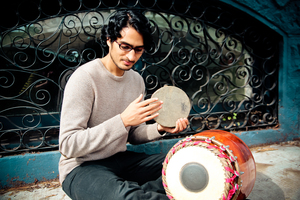Contribute
| In Conversation With Dr. Rohan Krishnamurthy |
Ranjani Saigal
08/13/2015
(This article is sponsored by Tanna Insurance)
It's amazing to imagine that I'd become a professional artist specializing in the mridangam having grown up in Kalamazoo, MI of all places! Although I'm the first person in my family to have had the opportunity to pursue music professionally, everyone in my family loves music. I was lucky to have a very supportive family and incredible teachers who encouraged my musical career at every step. That Damodaran Srinivasan, my first teacher, was based in Kalamazoo when I was 8 was destiny. After a few months of face-to-face training with him, he moved so we continued lessons over the speakerphone-- this was an early form of long-distance music education in the prehistoric/pre-Skype world! I continued lessons over the speakerphone for about a year and it worked out well.
The following year, I had the opportunity to meet maestro Guruvayur Dorai when he came to Michigan for a concert. I met him backstage and things just clicked. He graciously offered to be my teacher and told me to visit him in Chennai the next summer. It was an opportunity that no one could pass up and I began my training with him in 1997. I continued to learn from him whenever we met in Chennai and the U.S.
I'd been pursuing the arts and sciences since high school and decided to study a double major in music and chemistry at Kalamazoo College as a Heyl Scholar. I immersed myself in the study of many genres of Western music and started several cross-genre collaborations with orchestras, jazz ensembles, composers, and musicians from around the world. As my artistic and entrepreneurial careers were steadily expanding, I decided that I wanted to broaden and diversify my knowledge of different styles of music as much as I could. That’s when I commenced my master's in ethnomusicology and Ph.D. in musicology at the Eastman School of Music at the University of Rochester as a Provost Fellow, and completed my doctorate in 2013.
How did you modify the role of a traditional Mridangam artist to enable you make it a profession in the US?
To me, the arts are fundamentally about creative and critical thinking. The mridangam represents one of the most advanced, ancient, and popular rhythmic instruments in the entire world. With an instrument like the mridangam, the possibilities are truly limitless if you open your mind and ears to the diverse music and artistry all around you. As the next generation of such a rich tradition, you have the responsibility of being a musical and cultural ambassador to both preserve and propagate your rich body of knowledge. Music is definitely one of the most powerful ways to build bridges between communities. These bridges are vital in our ever-shrinking, interconnected global village. All of my cross-genre works are steps in this direction.
You have a PhD in Musicology and have studied music in the University. What special things did you learn at the western music schools and how did it shape your life as a musician?
My degrees at Kalamazoo College and Eastman allowed me to dive headfirst into the history, theory, and performance of many musical traditions, including many genres of Western classical music, jazz, Indonesian gamelan, Zimbabwean mbira, and others, while simultaneously advancing my focus in Indian music. Knowing multiple musical styles is like knowing multiple languages: it allows you to understand, create, appreciate, and communicate in so many more ways than if you only knew only one language. In the age of globalization and "fusion" where everyone tries to smoosh together different cultures, intentionally or unintentionally, this kind of polymusicality is key to long-term creativity and relevance. Interacting closely with world-class faculty and students allowed me to realize how unique my knowledge was, how I could constantly refine and expand on it, and how much I could learn by getting out of my artistic comfort zone.
My dissertation explores online music education and specially in the context of Carnatic percussion. This interdisciplinary research is at the intersection of ethnomusicology, performance, education, and technology, and is the first to analyze online music education in any style of music.
While at Kalamazoo College and Eastman, I founded and directed an accredited Indian Percussion Ensemble and acquired a rare set of Indian percussion instruments for both schools. I also founded and direct the Eastman Hand Drumming and Indian Rhythm summer institutes and have been teaching these unique college courses for the past 7 years. I'm currently offering a similar rhythm ensemble at Ohlone College in the San Francisco Bay Area, where I'm based.
You are a pioneer in recreating the Mridangam. What motivated you to do that? Are you considering any innovations with the skin as well?
With support from Eastman's Institute for Music Leadership, I received a patent for my new drum tuning system, which was inspired by years of research on the mridangam. This tuning system can be applied to any drum that needs to be fine-tuned and allows for simple and user-friendly tuning and head replacement. With my design, you can use traditional leather drumheads and still have ease of tuning-- tradition and innovation!
I'm partnering with Mid East, the well-known instrument retailer in Florida who I've worked with for several years, and will have my first batch of mridangams available in a few months. RohanRhythm deluxe (Mid East's name!) tabla, djembes, bongos, conga, and many other drums are in the pipeline. It's very exciting to see an idea transform into a tangible product. I'm glad that drummers around the world will no longer have to struggle to maintain their drums. I'm also working on developing an electronic counterpart for a variety of hand drums.
You are one of the very few Indian American classical music teachers. How would your teaching vary from a first generation teacher?
My performance, educational, and entrepreneurial projects are based on a creative balance of tradition and innovation. My pedagogy, whether in a college environment or private studio, draws from the personal and long-term relationship between teacher and student characteristic of the time-tested Indian tradition of gurukulavasa. At the same time, it's updated to a 21st-century context with a structured syllabus, fully notated and recorded compositions, diverse forms of digital technology and social media, college and career advising, and unique assignments that encourage students to dream beyond standard artistic goals. The RohanRhythm Studio is offered both in-person and online. We now have dozens of students—including in Boston— of all ages—2 to 70!—and backgrounds registered across four continents!
(Lokvani would like to share this quote that epitomizes what Rohan's teaching is all about)
“The RohanRhythm Percussion Studio is one of the most successful private percussion studios that specializes in South Indian drumming for an international audience. Directed by Dr. Rohan Krishnamurthy, a master musician, educator, and entrepreneur, the Studio utilizes cutting edge digital technology and structured pedagogy to inspire students of all ages, levels, and creative goals around the world. The curriculum is rigorous yet fun, and is likely to benefit drummers, instrumentalists, singers, dancers, composers, and general enthusiasts studying various genres of music. The Studio’s successful track record in innovative performance, music competitions, new cross-genre collaborations, scholarships and fellowships, and top college and professional placements is well documented. I am confident that those who join the Studio can begin the journey applying his or her creative potential and enriching the life of our larger society.â€
— Craig Woodson, Ph.D. - Music, U.C.L.A., Ethnomusicologist, Educator, Instrument Maker, Ethnomusic, Inc)
Do you think Carnatic music will ever be mainstreamed in the US ? What would be the path for that mainstreaming?
I'm not sure what "mainstream" actually means in the age of YouTube and Facebook! They say that the only song that everyone recognizes is "Happy Birthday"-- that's how fragmented and diversified the music industry has become, for better or worse.
There have been a number of artists around the world who have expanded the traditional scope of Indian-inspired music over the decades. I think every style of music will have certain people who continue the tradition the way that they learned it, and others who will try to take that tradition a step forward and create something new and meaningful. It's less about the music itself and more about the artists and their creativity and vision. It’s also important to remember that we perform for different audiences, who may be looking for everything from “mainstream†to “subcultural,†“alternative,†or “avant garde.†There are many layers to the global music industry and we have to be aware of who we are trying to connect to.
What are your ambitions for your musical journey?
Preserving and globalizing the incredible Indian rhythmic tradition, and advancing it through innovative and cross-genre projects. Every day presents me with so many new opportunities. The challenge is deciding what to pursue!
What advice do you have for youngsters who want to pursue Indian music as a career?
I'll get back to you on that when I'm 50!
My suggestion to all artists, regardless of what they specialize in, is to balance your specialized artistic knowledge with an entrepreneurial approach that allows you to identify and create opportunities for what you do. Artists are notoriously self-involved and self-fulfilled, but to do anything as a career requires that you offer something valuable to other people. What's valuable, and how that reaches people, is constantly changing and you have to stay ahead of the curve. It's really not that different from any other industry, but the entrepreneurial approach is usually not part of the music education. Whatever you do, do it meaningfully and for the right reasons.
How can people contact you?
Everything's available at RohanRhythm.com. I look forward to hearing from your readers!
You may also access this article through our web-site http://www.lokvani.com/

